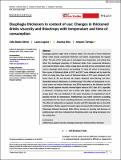Por favor, use este identificador para citar o enlazar a este item:
http://hdl.handle.net/10261/269389COMPARTIR / EXPORTAR:
 SHARE SHARE
 CORE
BASE CORE
BASE
|
|
| Visualizar otros formatos: MARC | Dublin Core | RDF | ORE | MODS | METS | DIDL | DATACITE | |

| Título: | Dysphagia thickeners in context of use: Changes in thickened drinks viscosity and thixotropy with temperature and time of consumption |
Autor: | Badia Olmos, Celia; Laguna Cruañes, Laura CSIC ORCID; Rizo, Arantxa; Tárrega, Amparo CSIC ORCID | Palabras clave: | Antithixotropy Apparent viscosity Dysphagia Temperatures Thickened drinks Thixotropy |
Fecha de publicación: | 18-abr-2022 | Editor: | John Wiley & Sons | Citación: | Journal of Texture Studies 53 (3): 383-395 (2022) | Resumen: | Dysphagia patients might need to thicken drinks. The viscosity of these thickened drinks varies among commercial thickeners and drinks compromising the ingesta safety. The aim of this study was to investigate how temperature and resting time affect the rheological properties of thickened drinks. Four commercial thickeners were used to thicken water, coffee, orange juice, and milk at two concentration levels used in dysphagia drinks (nectar and pudding). To study the effect of temperature, flow curves of thickened drinks at 10°C and 50°C were obtained and to study the effect of resting time, flow curves of thickened drinks at 25°C were obtained at different times (0, 30, and 60 min). All samples displayed shear-thinning and time-dependent behavior (thixotropy or antithixotropy). The effect of temperature on viscosity values and relative thixotropic area (RTA) depended on the thickener and the drink. Overall, apparent viscosity showed higher values at 50°C than 10°C, especially in thickeners containing starch and in drinks with higher soluble solids (milk and orange juice). This was attributed to the water absorption of pregelatinized starch granules favored by temperature. Antithixotropy was mainly observed at pudding concentration for the starch-containing thickeners, and decreased with temperature. The effect of resting time on apparent viscosity and RTA depended also on the drink and thickener. Mostly, apparent viscosity values increased with resting time and antithixotropic behavior decreased. Both effects, increase in viscosity and decrease of antithixotropy with time, indicated that thickening action was being developed over the resting time. | Versión del editor: | https://doi.org/10.1111/jtxs.12685 | URI: | http://hdl.handle.net/10261/269389 | DOI: | 10.1111/jtxs.12685 |
| Aparece en las colecciones: | (IATA) Artículos |
Ficheros en este ítem:
| Fichero | Descripción | Tamaño | Formato | |
|---|---|---|---|---|
| JTextureStudies2022-Badia.pdf | Artículo principal | 2,25 MB | Adobe PDF |  Visualizar/Abrir |
CORE Recommender
PubMed Central
Citations
3
checked on 27-abr-2024
SCOPUSTM
Citations
7
checked on 24-abr-2024
WEB OF SCIENCETM
Citations
6
checked on 29-feb-2024
Page view(s)
57
checked on 01-may-2024
Download(s)
177
checked on 01-may-2024

